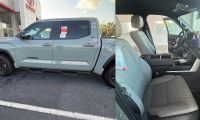During last week's CA State Senate meeting on electric vehicle deployment, GM's Shad Balch and Nissan's David Peterson both claimed the Toyota Prius was the number 1 traded-in vehicle for the Chevy Volt and Nissan Leaf. The claims came between trading barbs on the competing electric car fast charging standards, and could have been written off as car manufacturer one-up-manship, if it weren't for a press release published by GM a couple days ago making the same claim. While this is the sort of data car manufacturers must know, it isn't very well publicized.
Unfortunately a search for solid figures on the cars most traded in to buy electric cars came up largely empty handed, other than GM's recent press release, and a few reports last year.
As for why Prius owners would be trading to either a Chevy Volt or Nissan Leaf, the reason isn't the obvious one about Prius being early adopter clean vehicle enthusiasts who are a natural fit for electric car ownership. Instead it has to do with stickers allowing solo drivers to drive in the carpool lanes in California.
GM's press release talks about the large number of Chevy Volt buyers who have never been GM customers before. GM positions this as a success from developing the Volt, because it is winning new customers to GM. The Toyota Prius is the most traded in car, followed by the Toyota Camry, Honda Civic and BMW 3 Series.
“I owned a Prius for six years and loved it. I was one of the first to sign-up for the plug-in (version),” said Steve Glenn of Santa Monica, Calif. “While I was waiting for it to ship, I learned that the Volt would qualify for the HOV stickers, so I did a test drive. I fell in love then. It’s faster, better appointed and gets far better gas mileage than the Prius (or the plug-in). I've driven it over 1,000 miles and I've only used five gallons of gas.”
GM goes on to quote Shaun Del Grande, President of the Del Grande Dealership Group (DGDG) in Silicon Valley, to say that “On a daily basis new customers are coming into our dealership to check out the Volt because of its breakthrough technology and superior fuel economy. Our dealership is seeing new customers who are trading in Prius and Civic models, and we’re just getting started with electric vehicles.” DGDG's dealership chain also includes a Nissan dealership, where the Nissan Leaf is sold, as well as a Coda dealership where the all electric Coda sedan is sold.
Volt marketing manager Cristi Landy also said, “Nearly seven in 10 Volt buyers are new to Chevrolet.”
It was difficult to find much evidence for Nissan's claim that the Prius is the most traded in car for the Nissan Leaf.
Aside from David Peterson's statement last week, the sole report was published in October 2011 in the LA Times citing information from auto information company R.L. Polk & Co. That report showed that in both Volt and Leaf the vast majority of buyers were new to GM or Nissan car ownership respectively, and that in both cases the Toyota Prius was the most traded-in car.
Assuming this phenomena is true, why would it be? The obvious supposition is that Prius owners are environmentally concerned early adopters who might see an electric car as a way to "up their game" in environmental purity. While this line of thinking probably influences some Prius owners to switch to a pure electric car, the HOV stickers in California are a more compelling answer.
California's HOV lane program is meant to both encourage car sharing and reduce traffic congestion, as well as improve air quality by decreasing the number of solo drivers. California's metropolitan areas have clogged highways, and access to the HOV lane is highly desirable. In the late 90's a program was enacted giving electric, hybrid and CNG powered car owners stickers allowing solo drivers to drive in the HOV lane. This perk proved popular and many Toyota Prius's were sold solely for the gold HOV sticker. A couple years ago all the gold HOV stickers expired, leaving only the white HOV stickers for electric cars.
During 2011, a California Nissan Leaf buyer was eligible to get a white HOV sticker but a Chevy Volt buyer was not eligible for any HOV sticker. That's because the Leaf is a proper electric car, while the Volt is a plug-in hybrid despite all the claims of GM's marketing department to portray it as an electric car.
Beginning with cars built after Feb 6, 2012, the Chevy Volt is eligible for a new green HOV sticker. The Toyota Prius Plug-in is eligible for the same sticker. There is a cap of 40,000 green HOV stickers (there is no cap on the number of white stickers) and the cars must meet enhanced advanced technology partial zero emission vehicle (AT PZEV) requirements.
And while sales trends are influenced by many factors, Nissan Leaf sales have fallen this year while Chevy Volt sales have taken off. Leaf sales were 954 in December, 676 in January, 478 in February, 579 in March, and 370 in April. Volt sales were 1,529 in December, 603 in January, 1,023 in February, 2,289 in March, and 1,462 in April. How much this is due to the HOV stickers in California is anybody's guess.
What we can take from this is that electric car sales will not be driven on altruistic environmental reasons, but very pragmatic ones. In car-clogged California the HOV stickers can make the difference between a 30 minute and 1 hour commute.











Comments
Similar reason for
Permalink
Similar reason for Plug-In-Prius quick jump on sales:
From NY times article:
September 20, 2011, 1:10 PM
Banished from the H.O.V. Lane, Prius Drivers May Be First to Embrace New Plug-In Model
By JIM MOTAVALLI
Quote: California is already the country’s strongest market for alternative-powertrain cars, including the Prius. Sam Butto, a Toyota spokesman, said that California sales accounted for one out of every four in the United States.
“When those cars were eligible for California’s H.O.V. lanes, we sold out our allotment in no time,” Mr. Butto said. “We expect that the ability to use the H.O.V. lanes will be one of the most popular reasons people will buy the Prius Plug-In Hybrid. We may sell one in three or one in four of our plug-in hybrids in California.”
According to Scott Doggett, an editor at Edmunds’ AutoObserver.com, “When the H.O.V. access for California hybrids went away, it left thousands of drivers very frustrated, because their commute times had doubled or tripled. The ability to use H.O.V. lanes is a very good marketing tool for Toyota.”
"electric car sales will not
Permalink
"electric car sales will not be driven on altruistic environmental reasons, but very pragmatic ones" , I agree totally, I think you have one of the core forces driving EV sales.
But there are others driving factors as well, among volt drivers there is a core group of drivers who have switch from high end Volvos, Audis, Lexus, BMW and other "tech image" cars. One look at some of the forums shows why, while the Instant Torque electric motors are nice, and the volt is a luxury car in all but name, its the image that drivers are after. Unlike a pure electric, the volt can seamlessly replace a Audi, so GM is the one with the real opportunity with these drivers.
GM needs to run with this... Especially since the Volt is priced less than most of these competitors...
I personally think the Volt
Permalink
In reply to "electric car sales will not by Anonymous (not verified)
I personally think the Volt concept of driving initial miles in Electric then using the gas engine as basically a generator to charge the batteries as you drive is the right technology to develop. Batteries don't have the range that Americans are accustomed to but 70% - 90% of the time most of us do only drive 20 to 60 miles a day. As batteries improve the Voltec concept will just make driving more miles electric more common.
If every American had the Volt concept in their vehicle right now we would be able to eliminate OPEC from our list of oil providers. Eventually we will get to a solution where you can drive an electric car all of the time with no re-fueling worries. Until that time let's jump on the current technology and develop it so we can be the exporters of the infrastructure that will support it.
With all due respect, there
Permalink
With all due respect, there seems to be a spurious connection that is not substantiated with actual data.
I would appreciate any research on the following statement:
What percentage of Chevy Volts sold to date are HOV eligible?
My hypothesis: less than 10% (lower than 1000?)
The HOV version of the Volt was just introduced (even though the car has been out for more than a year) and the California sales of the Volt have been very low relative to the Nissan Leaf.